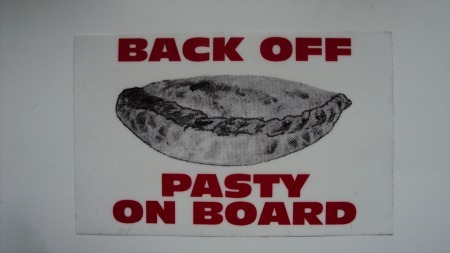The Tasty Cornish Pasty
When you come to St. Ives in Cornwall on the coast of England, known to some locally as the Cornish Riviera, you will notice Cornish pasty shops all up and down the dazzling beach walk. In fact, if you do nothing else in St. Ives, you should try a Cornish pasty. That is, of course, if you can dodge the swooping seagulls the size of cows and the throngs of tourists that crowd the narrow brick streets. Watch out for your dessert ice cream cone, though, because seagulls have been known to gulp down a scoop in mid-flight. Just a few words to the wise before you taste your first pasty.
Before you indulge, it is important to know a few facts about this original fast food, created for former tin miners to eat with two hands, using the bottom crust for holding. Apparently, it wasn't just dirt from the mines that would get on the pasty from the miners' fingers but arsenic as well. When you hold the Cornish pasty, you use the bottom to hold not eat. "Don't eat the dirty bit," warns Richard Marlow. "And avoid imitations."
Also, something like the ownership on champagne, the true Cornish pasty has to be called a Cornish pasty and be made from a certain percentage of chunks of beef (lumps of "proper meat") in a short pie (not puff pastry) with potatoes, onion, swede (a rutabaga/Swedish turnip), and pepper seasoning.
There is even the Cornwall Pasty Association, which precludes amateurs from copying the recipe incorrectly and mass-marketing it with derivative ingredients. You still see pasty wannabes in convenience stores all over Britain with processed meats; they just aren't the same. Even the shape of the pasty has to be a certain size and dimension and look like a majuscule "D."
And most importantly, the Cornish pasty has to be made in Cornwall. A bad pasty is called a nasty, and you want to avoid the nasty ones. Locals call the pasty an "oggy," truncated from the Cornish-language word "hoggan."
With Cornwall also being famous for cider, it is recommended that you pair up your pasty with a local cider crawl, especially if you're "chacking" (thirsty). You can buy the pasty on the street (and in pubs) and walk up the old brick to various drinking establishments where you can indulge in half-pints of scrumpy and cider, many of which come from nearby farms and are in barrels. You can go in one afternoon and have a pint of clear cider that tastes dry like white wine, and by the next day the same cider is orange/reddish and tastes a bit sweeter.
The sweetness and tartness of the cider is a perfect companion to the breaded meatiness of the Cornish pasty, and it supports all things local. Get some local ice cream after your pasty, but watch out for those maniacally diving seagulls.
All around Cornwall you will see minimum ingredients listed for pasties, 12.5 percent needing to be "real" meat, and many have 18 percent. And although there is the traditional, proprietary recipe, you'll see different types, like pork and apple, lamb and mint and, yes, even English breakfast stuffed into a pasty. There are vegetarian versions as well.
Finally, if you become a fan and end up eating this hearty food more than once (and drinking too much cider), perhaps go buy yourself a kitschy car-window sticker in a tourist shop. A favorite is: "BACK OFF/ PASTY ON BOARD." It's quite obvious that the next step would be to pasty it up on your back window.
Don't forget to buy this kitschy Cornish souvenir. Photo credit: Mark Damon Puckett
Mark Damon Puckett has written for Saveur and Greenwich Magazine. He is the author of The Reclusives, YOU with The Ill-usives and The Killer Detective Novelist (October 2012), all available on amazon.com and bn.com. Please visit him at www.markdamonpuckett.com.

